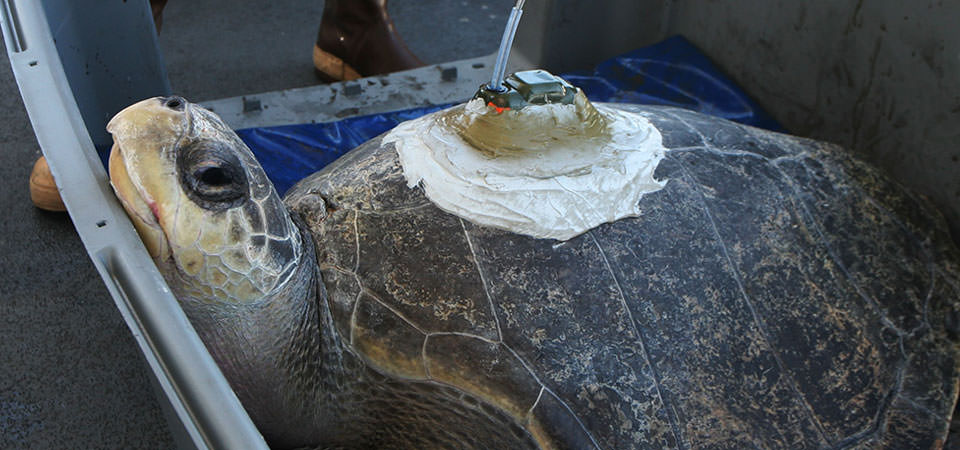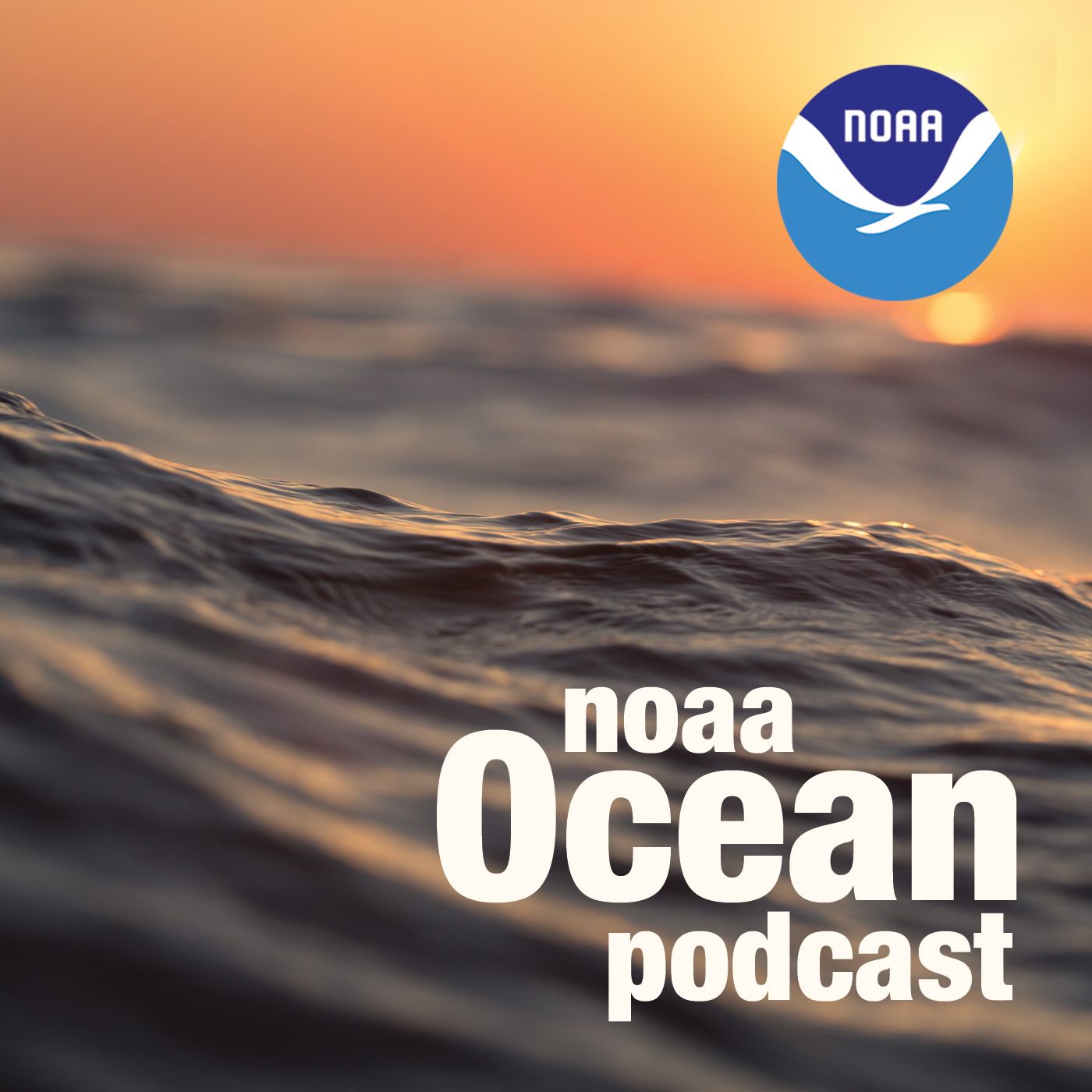Marine Animal Telemetry
NOAA Ocean Podcast: Episode 06
It's time for a NOAA Ocean Podcast "Science Moment," where we sample the best segments from our past full-length podcasts. In this episode, learn about marine animal telemetry, used to help scientist understand the ocean and marine life better.

Turtle Tale
The olive ridley turtle shown here washed up in the surf at Venice Beach in 2013. The distressed turtle suffered from hypothermia, starvation, and an inability to float. After rehabilitation that culminated in the turtle's recovery, the animal was released months later, equipped with a GPS antenna. This device allowed researchers from NOAA's Southwest Fisheries Science Center and the Aquarium of the Pacific to track the released turtle's movements. In particular, scientists wanted to know whether the turtle would migrate south toward Mexico and warmer waters or remain in California's coastal waters, where it was initially found. The transmitter tracked the turtle's movements for several weeks, at which point it either ran out of battery life or fell off the turtle. Nearly six weeks worth of data indicate the turtle migrated to warmer waters. This information augments existing satellite telemetry tagging studies, allowing scientists to better understand the olive ridleys' migration between feeding and breeding grounds, which often occurs over great distances. Read the full story about this turtle.
Transcript
HOST: It's time for a NOAA Ocean Science Moment! I'm Megan Forbes and in today's science moment we're taking a look at Marine Animal Telemetry. The word telemetry can refer to almost anything that emits a signal at a distance. When a sensor with a signal is attached to an aquatic animal, we call that marine animal telemetry. Marine animal telemetry is used to help scientists understand the ocean and marine life better. Listen in as NOAA Ocean's Kate Nielsen talks with Zdenka Willis, the former director of the U.S. Integrated Ocean Observing System, about the benefits of marine animal telemetry.
KATE NIELSEN: So, why do we do animal tagging? What is the benefit of this?
ZDENKA WILLIS: Data from these animals are transforming the way scientists study our waters and opening up new data sources. This technology is leading to profound advancements in understanding these animals and how they interact where they live. The knowledge translates to a better understanding of our planet. This technology allows researchers to investigate how animals use their three-dimensional world and quantify important biological aspects of their environments. This data can be used to improve ocean forecasting by reducing errors. There's also a commercial aspect to this effort in providing information and guidance to maintaining sustainable and commercial fisheries. Fisherman know that to remain viable they need to decrease their by-catch and avoid endangered species and this tag information can help them do that.
KATE NIELSEN: Let's talk just a little bit about what the tag is like. What can you tell us about that?
ZDENKA WILLIS: So think of little tiny computers that record and store data about the animals and their environment. Generally, a researcher must recover a tag to download the data, we call that an archival tag. Other tags can transfer information acoustically or by satellite. Sometimes, we insert them inside the body of the animal and other times they're on the outside. So think of a little chip or a microphone. The type of tag and the size of the tag is dependent on the animal and the information we want to collect.
KATE NIELSEN: Are there certain species that this tagging works better with than others?
ZDENKA WILLIS: Yeah, there are many things that we tag. We tag salmon, sturgeon, halibut, seals, sea lions, and fur seals, fish from very small to large ones like tuna and sharks, whales, eels, turtles, seabirds like albatross, squid, crustaceans, and others. Collectively all of these tags tell us a significant amount about their behavior. So depending on what we need to study and what we want to study, that's what we'll tag. As in most scientific studies, sometimes things don't always go perfectly. But the people who are doing the tagging, they have such a love for the animals and the environment. The last thing they want to do is hurt the animals. They're really trying to help them by understanding their behavior.
KATE NIELSEN: Are tags removed after so much time or do you ever lose tags?
ZDENKA WILLIS: So it depends on the type of tag. There are some tags which the scientist will remove. Some of them are programmed actually to release from the animal and come to the surface and through their signal, we'll track them down. And of course, yes, some of them get lost, some of them we recover, and some of them we don't. We had one that we thought we were tracking large squid on the bottom of the ocean and really what we think it was was a tag that was just sitting on the bottom of the ocean.
KATE NIELSEN: Oh no! So onto this data that you receive, what kind of data do these tags actually collect?
ZDENKA WILLIS: So we collect a number of environmental information like temperature, conductivity, light level, oxygen, and chlorophyll, and equally exciting is we collect information about the animals themselves, like their migration routes, how deep do they dive, where do they live, where do they hang out…
But it also really helps the scientists better understand the habitat requirements of the marine animals, how they move with the flow of tides and currents, and it provides insight on how they may be altering their behavior or migration patterns in response to climate change. We really need to understand what's happening before anyone can help the animals.
KATE NIELSEN: So where is the data collected? Are there projects that are around the U.S. or is this focused more in just one area where you're trying to collect this data?
ZDENKA WILLIS: So these different scientists are actually collecting information in all of our U.S. waters. The major challenge that we have is to synchronize the many tagging programs and improving data sharing to the broader ocean science community. And that's where IOOS comes in. Scientists are already collecting this data for their own research. By bringing it together, we can make it available on the broader scale.
HOST: We hope you've enjoyed this NOAA Ocean Science Moment! If you liked this podcast and want to hear more, search for The NOAA Ocean Podcast in your podcast catcher of choice or visit oceanservice.noaa.gov.

From corals to coastal science, connect with ocean experts to explore questions about the ocean environment.
Subscribe to Feed | Subscribe in iTunes
Browse All Episodes of the NOAA Ocean podcastDid you know?
In 2016, U.S. IOOS began hosting the multi-agency Animal Telemetry Network (ATN) program, which aims to coordinate and support marine animal telemetry infrastructure and operations while ensuring consistent availability of marine animal telemetry data in the U.S. This includes the public launch of a national Data Assembly Center or DAC to serve as an access point to search, discover and access animal telemetry data and associated oceanographic datasets from a wide variety of species and platforms. A collaborative effort between IOOS and the Office of Naval Research working with Stanford University and the NOAA Southwest Fisheries Science Center Environmental Research Division (SWFSC/ERD), the DAC aggregates telemetry data collected by federal and non-federal organizations in the and makes it publicly accessible via a web portal enabling broad-scale national issues to be addressed.
